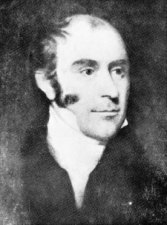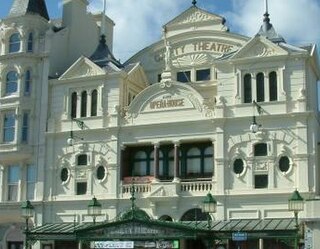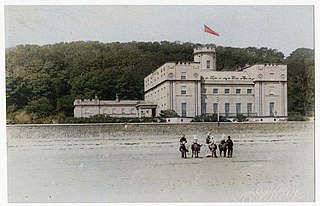
Douglas is the capital city and largest settlement of the Isle of Man, with a population of 26,677 (2021) and an area of 10.5 km2. It is located at the mouth of the River Douglas, and on a sweeping bay of two miles. The River Douglas forms part of the city's harbour and main commercial port.

Laxey is a village on the east coast of the Isle of Man. Its name derives from the Old Norse Laxa meaning 'Salmon River'. Its key distinguishing features are its three working vintage railways and the largest working waterwheel in the world. It is also the location of King Orry's Grave.

The culture of the Isle of Man is influenced by its Celtic and, to a lesser extent, its Norse origins, though its close proximity to the United Kingdom, popularity as a UK tourist destination, and recent mass immigration by British migrant workers has meant that British influence has been dominant since the Revestment period. Recent revival campaigns have attempted to preserve the surviving vestiges of Manx culture after a long period of Anglicisation, and significant interest in the Manx language, history and musical tradition has been the result.

The first USS Gettysburg was a steamer in the United States Navy. The ship was built in Glasgow, Scotland, in 1858, named RMS Douglas, and operated by the Isle of Man Steam Packet Company in the United Kingdom between Liverpool, England, and Douglas on the Isle of Man until November 1862. She was then sold to Cunard, Wilson & Company on behalf of the Confederate agents Fraser, Trenholm & Company for use by the Confederate States of America during the American Civil War. Renamed Margaret and Jessie, she operated as a blockade runner until her capture by the Union on 5 November 1863. The ship then was commissioned into the Union Navy on 2 May 1864 as USS Gettysburg.

The Tower of Refuge from Shipwreck, referred to as the Tower of Refuge, is a stone-built castellated structure which was erected on St Mary's Isle in Douglas Bay, Isle of Man, in order to afford shelter to mariners wrecked on the rock. The tower was constructed through the endeavours of Sir William Hillary, who had been instrumental in several rescues of sailors stranded on the rock, and which culminated in the heroic rescue of the crew of the Saint George Steam Packet Company steamer RMS St George, when it foundered on the rock in the early hours of November 20, 1830. Sir William personally contributed a high proportion of the costs and secured a substantial number of public contributions for funding the structure.

John Allen Mylrea MHK, was a member of the House of Keys, Chairman of the Isle of Man Steam Packet Company and a director of Dumbell's Bank, who in the late 19th century played a prominent part in the arts and culture of the Isle of Man.

John McHutchin, was a Manx lawyer who successively became High Bailiff of Douglas, Second Deemster and Clerk of the Rolls in the Isle of Man.

The Gaiety Theatre and Opera House is a theatre in Douglas, Isle of Man which together with the Villa Marina forms the VillaGaiety complex. The Gaiety is situated on Douglas promenade, overlooking the sea and adjacent to the Villa Gardens, Arcade and Butts.
Francis Pigott Stainsby Conant was a British Whig politician who became the Lieutenant Governor of the Isle of Man from 22 October 1860 until his sudden death in 1863.

Douglas Harbour is located near Douglas Head at the southern end of Douglas, the capital of the Isle of Man. It is the island's main commercial shipping port. The Port of Douglas was the first in the world to be equipped with radar.

William Gill was a Manx merchant navy officer who served as commanding officer of numerous Isle of Man Steam Packet Company vessels. Gill was the first recognised captain of the line, retiring with the rank of Commodore.

The St Mary of the Isle Cathedral, also referred to as the Cathedral of St Mary of the Isle, is a Roman Catholic cathedral in Douglas, Isle of Man. It is part of the Roman Catholic Pastoral Area of St Maughold within the Archdiocese of Liverpool. It is one of two cathedrals on the Island, and one of six Catholic churches. It is referred to locally as St. Mary's. In September 2023, St Mary of the Isle was granted co-cathedral status.

David "Dawsey" Kewley was a Manx boatman, member of the Douglas Rocket Brigade and volunteer in the Lifeboat Service, renowned for his involvement in the saving of lives at sea. Reports of the number of people he saved from drowning vary. According to some contemporary reports he saved as many as 38 lives, according to others 25, but it is generally recognised that he was directly involved in saving the lives of at least 23 people, and as a member of the Douglas Lifeboat Crew assisted in the saving of many more. He was a recipient of numerous awards from the Royal Humane Society for his life-saving exploits. Although a man of dauntless courage, he would never speak about his feats and disliked hearing other people talk about them.

Samuel Harris QC was a Manx advocate, businessman and philanthropist who became High Bailiff of Douglas and a member of the Legislative Council of the Isle of Man. He was also a founder of the Isle of Man Bank and a director of the Isle of Man Steam Packet Company.
John Kelly was a Manx advocate who became High Bailiff of Castletown and a Member of the House of Keys.

Henry Bloom Noble JP was a Cumbrian-born philanthropist and businessman who at the time of his death was the richest resident of the Isle of Man. Noble bequeathed a large amount of his vast fortune to the people of the Isle of Man, resulting in numerous civic amenities such as recreation grounds, swimming baths, a library and a hospital.
James Alfred Caine, known as "Jim the Jazz," was a Manx jazz pianist, radio presenter and raconteur whose career, in various parts, spanned over 70 years.

Arthur Binns Crookall JP, MLC, CP, was a philanthropist, Mayor of the Borough of Douglas, a member of both branches of Tynwald, Chairman of the Isle of Man Steam Packet Company and Chairman of the Isle of Man Railway Company who at his death was one of the wealthiest people on the Isle of Man.

Castle Mona is a former private residence later used as a hotel in Douglas, Isle of Man. The house was built between 1803 and 1804 for John Murray, 4th Duke of Atholl during his capacity as the Isle of Man's Governor General. Before 1850, Queen Victoria proposed buying it as a more suitable royal residence than Osborne House.
Douglas East is a Ward in Douglas, Isle of Man whose boundaries are the same as the House of Keys constituency Douglas East. The ward was formed for the 2021 local authority elections following the abolition of Derby and Victoria Wards.


















